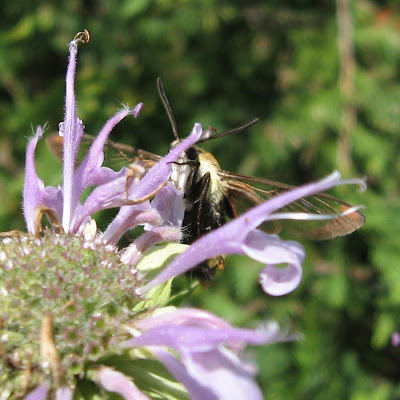... and for many species it's also a means of ensuring survival. Batesian mimicry is a kind of mimicry where a harmless species has evolved to imitate the warning signals of a stinging, toxic or in other way dangerous species. (This is different than mimesis, where the mimic assumes the colors and/or profile of, for example, a leaf, twig or bark).
Hummingbird moths generally hover while nectaring and are seldom seen sitting as this one is. I'm calling this a Snowberry Clearwing (Hemaris diffinis) but since this is the only image thus far perhaps the name should be left at the genus level. Ventral view(s) would have helped confirm the species. Further reading at BugGuide.Net

This helps. Not the best of pictures since it's hard to aim the camera at a moving target, but the underside of the moth is visible, and it fits the description for Hemaris diffinis. In the field, even while hovering or flying, this clearwing appears smaller and its color is distinctly greenish compared to ...


... the Hummingbird Clearwing Moth (Hemaris thysbe), nectaring at wild bergamot. This moth has red on the dorsal surface of the abdomen and whitish legs (compare to the legs of the moth depicted above).

Ventral and dorsal views of another Hemaris thysbe


Its overall solid blue-black colors, habit of flicking its tinted wings, and quick nervous manner of moving about while nectaring ... everything about the appearance and behaviour of this Chalcosyrphus chalybeus indicated it was a solitary spider wasp. This insect is actually a species of flower fly, of the family Syrphidae, related to the ubiquitous little black-and-yellow striped hover flies commonly encountered in fields and gardens.



Here are a few more insect imposters I've stumbled across on my travels through thickets of thistles, nettles, prickly ash and poison ivy.
A Tachinid fly, Cylindromyia sp.

A female Clematis Clearwing Moth (Alcathoe caudata)

A species of Long-horned Beetle, Clytus ruricola


A fly, Macroceromys terminalis (formerly genus Xylomya). Thanks to David Bree for help with the I.D. on this one.

This small wasp-like robber fly is only about 10 mm long. At first I thought it might be a species of Eudioctria but having done more research on the Internet it seems this is more likely a member of the Laphria sicula/canis/winnemana complex. The first image is a bit out of focus but the long proboscis is quite visible. And it wasn't long before the fly put it to use ... it looks like it has captured a small beetle.





